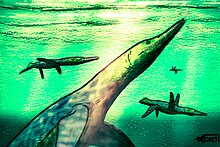| Rarosaurus Temporal range:
| |
|---|---|

| |
| Reconstruction of several individuals of Rarosaurus singularis | |
| Scientific classification | |
| Domain: | Eukaryota |
| Kingdom: | Animalia |
| Phylum: | Chordata |
| Class: | Reptilia |
| Superorder: | †Sauropterygia |
| Order: | †Plesiosauria |
| Family: | †Polycotylidae |
| Genus: | †Rarosaurus Kaddumi, 2009[1] |
| Species: | †R. singularis
|
| Binomial name | |
| †Rarosaurus singularis Kaddumi, 2009
| |
Rarosaurus is an extinct genus of polycotylid plesiosaur that lived during the Late Cretaceous. It contains one valid species, R. singularis and it was found in the Muwaqqar Chalk Marl Formation of Jordan.[1]
Discovery and naming[edit]
The holotype, a partial rostrum with teeth, was discovered in the Muwaqqar Chalk Marl Formation of Jordan. It was named and described by Kaddumi (2009).[1]
Description[edit]
Rarosaurus is known from the rostral portion of a fossil skull, which is well preserved and bears teeth. The fossil is about twenty centimetres long and very elongate. The surface of the bone is rugose, marked by small holes and grooves. The teeth are relatively short and conical; the first tooth in the jaw protrudes far forward.[1]
It is notable for being the latest-surviving polycotylid and is currently the only one from the late Maastrichtian.[1]
Naming[edit]
The generic name Rarosaurus means "rare lizard", and is attributed to the paucity of plesiosaur fossils where it was found. The specific name singularis refers to the type specimen of Rarosaurus being the only plesiosaur specimen found from the area.[1]